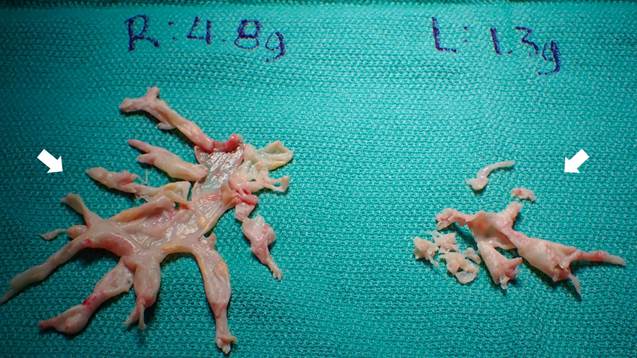The accompanying image demonstrates chronic endothelialized scar tissue that was extracted surgically from a patient with chronic thromboembolic pulmonary hypertension (CTepH) during a pulmonary endarterectomy (Image 1). CTEPH is an uncommon condition that occurs as a sequela of acute pulmonary embolism. Residual embolic burden and hypercoagulability precipitates remodeling of the pulmonary arterial vasculature resulting in intimal thickening and fibrosis. Consequently, the pulmonary vascular resistance increases precipitating precapillary pulmonary hypertension. Increased right ventricular afterload results in chamber hypertrophy, dilatation and dysfunction. Concomitant tricuspid valve annular dilatation can lead to severe tricuspid regurgitation. Development of tricuspid regurgitation is detrimental as it leads to volume overloading of the right ventricle worsening dysfunction. Additionally, it compromises cardiac output, as the right ventricle preferentially empties into the lower pressure right atrial chamber than into the high resistance pulmonary vascular during systole. Pressure and volume overloading of the right ventricle lead to leftward bowing of the interventricular septum, which in turn, compromises left-ventricular filling and decreases cardiac output further. In conjunction with a compromised cardiac output, hypoxemia related to ventilation/ perfusion mismatching in pulmonary hypertension jeopardizes systemic oxygen content and oxygen tissue delivery. Consequently, patients often present with persistent exercise intolerance, dyspnea and fatigue. Ventilation/ perfusion scanning, computed-tomographic angiography and right-heart-catheterization help corroborate the diagnosis of CTEPH. Cardiopulmonary bypass support and circulatory arrest are needed to facilitate complete surgical bilateral pulmonary endarterectomy; a curative procedure that involves surgically extracting the chronic endothelialized scar tissue from the pulmonary arteries.(1-3

Source: Authors.
Image 1 Chronic endothelialized scar tissue extracted surgically (during a pulmonary endarterectomy) from a patient with chronic thromboembolic pulmonary hypertension.
Pre-induction institution of invasive arterial monitoring is important in these patients. Decreases in right ventricular coronary perfusion related to anesthesia-induced systemic hypotension, can precipitate complete right ventricular failure, further compromising left ventricular filling. Cardiovascular collapse can rapidly ensue under such circumstances. preserving right ventricular function during induction necessitates judicious dosing of anesthetic drugs and commencing vasopressin or phenylephrine infusions to mitigate decreases in mean arterial pressure. Post-induction, transesophageal echocardiography examination helps rule out presence of right heart thrombi prior to placement of a pulmonary-artery-catheter. If right atrial or ventricular thrombi are noted, the pulmonary artery catheter is inserted into the superior vena cava and advancement in to the right atrium is avoided lest the catheter leads to pulmonary embolization of the thrombi and worsening of pulmonary hypertension. In such circumstances, the surgeons can help pass the pulmonary artery catheter into the pulmonary artery after completion of thromboendarterectomy. Pulmonary artery catheterization helps assess pulmonary vascular resistance and consequently, success of surgical endarterectomy. Post-endarterectomy, right ventricular failure or reperfusion injury related pulmonary edema may necessitate institution of extracorporeal support to facilitate successful weaning off cardiopulmonary bypass.1,3











 texto en
texto en 



